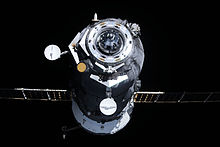cosmos.wikisort.org - Spacecraft
Progress M-10M (Russian: Прогресс М-10М), identified by NASA as Progress 42P, is a Progress spacecraft which was launched on 27 April 2011 to resupply the International Space Station.[1][2] It was the tenth Progress-M 11F615A60 spacecraft to be launched, and has the serial number 410. The spacecraft was manufactured by RKK Energia, and is operated by the Russian Federal Space Agency. On 29 April 2011, it arrived at the space station's Pirs Docking Compartment during Expedition 27.[3]
 Progress M-10M approaches the ISS on 29 April 2011. | |
| Mission type | ISS resupply |
|---|---|
| Operator | Roskosmos |
| COSPAR ID | 2011-017A |
| SATCAT no. | 37396 |
| Mission duration | 185 days |
| Spacecraft properties | |
| Spacecraft type | Progress-M s/n 410 |
| Manufacturer | RKK Energia |
| Start of mission | |
| Launch date | 27 April 2011, 13:05:21 UTC |
| Rocket | Soyuz-U |
| Launch site | Baikonur, Site 1/5 |
| End of mission | |
| Disposal | Deorbited |
| Decay date | 29 October 2011, 13:00 UTC |
| Orbital parameters | |
| Reference system | Geocentric |
| Regime | Low Earth |
| Inclination | 51.6° |
| Epoch | 27 April 2011 |
| Docking with ISS | |
| Docking port | Pirs nadir |
| Docking date | 29 April 2011, 14:29 UTC |
| Undocking date | 29 October 2011, 09:04 UTC |
| Time docked | 183 days |
| Cargo | |
| Mass | 2645 kg |
| Pressurised | 1349 kg |
| Fuel | 879 kg |
| Gaseous | 50 kg |
| Water | 420 kg |
Progress ISS Resupply | |
Launch
Progress M-10M lifted off from launch pad number 1 of the Baikonur cosmodrome at 13:05 UTC on 27 April 2011. Progress M-10M achieved the preliminary planned orbit after nine minutes of the launch. Onboard commands were issued to unfurl the spacecraft's communications and navigation antennas and extend two power-generating solar arrays. A series of engine firings over the next two days guided the spacecraft toward a linkup with the International Space Station (ISS).
Docking
Progress M-10M autonomously flew for two days after the launch and arrived at the ISS on 29 April 2011, successfully docking to the nadir port of the Pirs at 14:19 UTC.[4] The docking occurred as the two spacecraft were traveling 354 kilometres over western Mongolia. The linkup happened just over five hours before NASA's first launch attempt of the Space Shuttle Endeavour on STS-134 mission. The shuttle launch was scrubbed because two heaters on one of Endeavour's auxiliary power units failed.
Cargo
Inventory
Total cargo mass delivered: 2645 kg
| Item description [5] | Mass (kg) |
|---|---|
| Propellant in the propulsion system tanks for the ISS needs | 250 |
| Propellant in the refuelling system tanks | 627 |
| Oxygen | 51 |
| Water in the Rodnik system tanks | 420 |
| Items in the cargo compartment | 1297 |
| Gas supply system | 24 |
| Water supply system | 20 |
| Thermal control system | 14 |
| On-board hardware control system | 12 |
| Individual protection items | 62 |
| Maintenance and repair equipment | 10 |
| Sanitary and hygienic items | 118 |
| Food containers, fresh products | 192 |
| Medical equipment, linen, personal hygienic and prophylactics items | 94 |
| Science experimental hardware, including experimental items | 141 |
| Russian crew's items | 88 |
| On-board documentation files, crew provisions, video- and photo-equipment | 22 |
| FGB-hardware | 54 |
| US Orbital Segment hardware | 444 |
Undocking and decay

Progress M-10M undocked nominally at 09:04 UTC on 29 October 2011 from the nadir port of the Pirs Docking Compartment after hooks open command at 09:01 UTC. An automated 15 seconds separation burn followed at 09:07 UTC. The cargo ship, loaded with trash, performed its 3-minute deorbit burn at 12:10:30 UTC. It entered the Earth's atmosphere at 12:48 UTC and burned up at 12:54 UTC. Surviving debris impacted in the Pacific Ocean at around 13:00 UTC.
With the Progress M-10M undocking, the Space Station was in a very rare configuration of having only one Russian vehicle docked (Soyuz TMA-02M at Rassvet Module). The last time this situation occurred was in March 2009.
References
- Justin Ray (27 April 2011). "Space station resupply ship launched ahead of Endeavour". Spaceflight Now. Retrieved 27 April 2011.
- Peter Harding (27 April 2011). "Progress M-10M launches on cargo run to International Space Station". NASAspaceflight.com. Retrieved 27 April 2011.
- Mu Xuequan (29 April 2011). "Russian Progress cargo ship docks with ISS". Xinhua News Agency. Archived from the original on 12 May 2011. Retrieved 29 April 2011.
- SPACE.com Staff (29 April 2011). "Russian Cargo Ship Docks at Space Station Ahead of Shuttle Launch". SPACE.com. Retrieved 30 April 2011.
- Russian Federal Space Agency (29 April 2011). "Progress M-10M to Arrive at the ISS Today". Retrieved 30 April 2011.
External links
На других языках
- [en] Progress M-10M
[ru] Прогресс М-10М
Прогресс М-10М — транспортный грузовой космический корабль (ТГК) серии «Прогресс», запущенный к Международной космической станции. 42-й российский корабль снабжения МКС.[1] Серийный номер 410.Другой контент может иметь иную лицензию. Перед использованием материалов сайта WikiSort.org внимательно изучите правила лицензирования конкретных элементов наполнения сайта.
WikiSort.org - проект по пересортировке и дополнению контента Википедии
